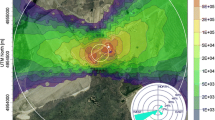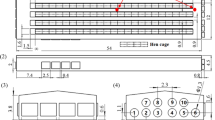Abstract
Increased bioaerosol loadings in downwind plumes from concentrated animal feeding operations (CAFOs) may increase the risk for allergy and infection in humans. In this study, we monitored airborne concentrations of culturable bacteria and fungi at upwind (background) and downwind sites at a 10,000 milking cow dairy over the course of a year. The average bacterial concentrations at the upwind site were 8.4 × 103 colony forming units (CFU) m−3 and increased to 9.9 × 105 CFU m−3 at the downwind edge of the cattle lots, decreasing to 6.3 × 104 CFU m−3 200 m farther downwind. At the same sites, the average fungal concentrations were 515, 945, and 1,010 CFU m−3, respectively. Significant correlations between the ambient weather conditions and airborne fungal and bacterial concentrations were identified. Sequence analysis of PCR-amplified DNA from bacterial clones and fungal isolates revealed genus and species level differences between upwind and downwind sites. Although we could not cultivate gram-negative bacteria, bacterial clones at downwind sites identified as being gram-negative matched with the following genera: Acinetobacter, Bradyrhizobium, Escherichia, Idiomarina, Methylobacterium, Ralstonia, and Novosphingobium. Fungal isolates from downwind matched with the following genera: Acremonium, Alternaria, Ascomycte, Aspergillus, Basidiomycete, Cladosporium, Davidiella, Doratomyces, Emericella, Lewia, Onygenales, Penicillium, Rhizopus, and Ulocladium. None of the bacterial and fungal sequence matches were affiliated with genera and species known to be pathogenic to humans. Overall, the data suggest that exposure to bioaerosols in the downwind environment decreases with increasing distance from the open-lot dairy.



Similar content being viewed by others
References
Adhikari, A., Sen, M. M., Gupta-Bhattacharya, S., & Chanda, S. (2004). Volumetric assessment of airborne fungi in two sections of a rural indoor dairy cattle shed. Environment International, 29, 1071–1078.
Blanchard, D. C., & Syzdek, L. (1970). Mechanism for the water-to-air transfer and concentration of bacteria. Science, 170, 626–628.
Brandi, G., Sisti, M., & Amagliani, G. (2000). Evaluation of the environmental impact of microbial aerosols generated by wastewater treatment plants utilizing different aeration systems. Journal of Applied Microbiology, 88, 845–852.
Brooks, J. P., Gerba, C. P., & Pepper, I. L. (2004). Biological aerosol emission, fate, and transport from municipal and animal wastes. Journal of Residuals Science & Technology, 1, 15–28.
Brooks, J. P., Tanner, B. D., Josephson, K. L., Gerba, C. P., Haas, C. N., & Pepper, I. L. (2005). A national study on the residential impact of biological aerosols from the land application of biosolids. Journal of Applied Microbiology, 99, 310–322.
Brown, J. K. M., & Hovmoller, M. S. (2002). Aerial dispersal of pathogens on the global and continental scales and its impact on plant disease. Science, 297, 537–541.
Carducci, A., Gemelli, C., Cantiani, L., Casini, B., & Rovini, E. (1999). Assessment of microbial parameters as indicators of viral contamination of aerosol from urban sewage treatment plants. Letters in Applied Microbiology, 28, 207–210.
Centner, T. J. (2003). Regulating concentrated animal feeding operations to enhance the environment. Environmental Science & Policy, 6, 433–440.
Chang, C. W., Chung, H., Huang, C. F., & Su, H. J. J. (2001). Exposure of workers to airborne microorganisms in open-air swine houses. Applied and Environmental Microbiology, 67, 155–161.
Cox, C. S. (1995a). Physical aspects of bioaerosol particles. In C. S. Cox & C. M. Wathes (Eds.), Bioaerosols Handbook (pp. 15–25). New York: Lewis Publishers.
Cox, C. S. (1995b). Stability of airborne microbes and allergens. In C. S. Cox & C. M. Wathes (Eds.), Bioaerosols handbook (pp. 77–99). New York: Lewis Publishers.
Crook, B., & Sherwood-Higham, J. L. (1997). Sampling and assay of bioaerosols in the work environment. Journal of Aerosol Science, 28, 417–426.
Dungan, R. S., & Leytem, A. B. (2009a). Airborne endotoxin concentrations at a large open-lot dairy in southern Idaho. Journal of Environmental Quality, 38, 1919–1923.
Dungan, R. S., & Leytem, A. B. (2009b). Qualitative and quantitative methodologies for determination of airborne microorganisms at concentrated animal-feeding operations. World Journal of Microbiology and Biotechnology, 25, 1505–1518.
Eaton, A. D., Clesceri, L. S., Rice, E. W., & Greenberg, A. E. (2005). Standard methods for the examination of water and wastewater (21st ed.). Washington DC: American Public Heath Association, American Water Works Association, Water Environment Federation.
Ehrlich, R., Miller, S., & Walker, R. L. (1970). Relationship between atmospheric temperature and survival of airborne bacteria. Applied Microbiology, 19, 245–249.
Fracchia, L., Pietronave, S., Rinaldi, M., & Martinotti, M. G. (2006). The assessment of airborne bacterial contamination in three composting plants revealed site-related biological hazard and seasonal variations. Journal of Applied Microbiology, 100, 973–984.
Gardes, M., & Bruns, T. D. (1993). ITS primers with enhanced specificity for basidiomycetes–application to the identification of mycorrhizae and rusts. Molecular Ecology, 2, 113–118.
Green, C. F., Gibbs, S. G., Tarwater, P. M., Mota, L. C., & Scarpino, P. V. (2006). Bacterial plume emanating from the air surrounding swine confinement operations. Journal of Occupational and Environmental Hygiene, 3, 9–15.
Hall, T. A. (1999). BioEdit: A user-friendly biological sequence alignment editor and analysis program for Windows 95/98/NT. Nucleic Acids Symposium Series, 41, 95–98.
Heederik, D., Sigsgaard, T., Thorne, P. S., Kline, J. N., Avery, R., Bønløkke, J. H., et al. (2007). Heath effects of airborne exposures from concentrated animal feeding operations. Environmental Health Perspectives, 115, 298–302.
Jones, A. M., & Harrison, R. M. (2004). The effects of meteorological factors on atmospheric bioaerosol concentrations-a review. Science of the Total Environment, 326, 151–180.
Kiekhaefer, M. S., Donham, K. J., Whitten, P., & Thorne, P. S. (1995). Cross seasonal studies of airborne microbial populations and environment in swine buildings: Implications for worker and animal health. Annals of Agricultural and Environmental Medicine, 2, 37–44.
Li, D.-W., & Kendrick, B. (1995). A year-round study of functional relationships of airborne fungi with meteorological factors. International Journal of Biometeorology, 39, 74–80.
Lighthart, B. (1994). Physics of microbial bioaerosols. In B. Lighthart & A. J. Mohr (Eds.), Atmospheric microbial aerosols: Theory and applications (pp. 5–27). New York: Chapman & Hall.
Lin, X., Reponen, T. A., Willeke, K., Grinshpun, S. A., Foarde, K. K., & Ensor, D. S. (1999). Long-term sampling of airborne bacteria and fungi into a non-evaporating liquid. Atmospheric Environment, 33, 4291–4298.
Marchesi, J. R., Sato, T., Weightman, A. J., Martin, T. A., Fry, J. C., Hiom, S. J., et al. (1998). Design and evaluation of bacterium-specific PCR primers that amplify genes coding for bacterial 16S rRNA. Applied and Environmental Microbiology, 64, 795–799.
Marthi, B., Fieland, V. P., Walter, M., & Seidler, R. J. (1990). Survival of bacteria during aerosolization. Applied and Environmental Microbiology, 56, 3463–3467.
Millner, P. D. (2009). Bioaerosols associated with animal production operations. Bioresource Technology, 100, 5379–5385.
Mohr, A. J. (2007). Fate and transport of microorganisms in air. In C. J. Hurst, et al. (Eds.), Manual for environmental microbiology (pp. 952–960). Washington DC: ASM Press.
Muyzer, G., DeWaal, E. C., & Uitterlinden, A. G. (1993). Profiling complex microbial populations by denaturing gradient gel electrophoresis analysis by polymerase chain reaction-amplified genes coding for 16s rRNA. Applied and Environmental Microbiology, 59, 695–700.
Nicholson, K. W. (1995). Physical aspects of bioaerosol sampling and deposition. In C. S. Cox & C. M. Wathes (Eds.), Bioaerosols handbook (pp. 27–53). New York: Lewis Publishers.
Pillai, S. D., & Ricke, S. C. (2002). Bioaerosols from municipal and animal wastes: Background and contemporary issues. Canadian Journal of Microbiology, 48, 681–696.
Poon, C. P. C. (1966). Studies on the instantaneous death of airborne Escherichia coli. American Journal of Epidemiology, 84, 1–9.
Reysenback, A. L., Wickham, G. S., & Pace, N. R. (1994). Phylogenetic analysis of the hyperthermophilic pink filament community in Octopus Spring, Yellowstone National Park. Applied and Environmental Microbiology, 60, 2113–2119.
Rule, A. M., Chapin, A. R., McCarthy, S. A., Gibson, K. E., Schwab, K. J., & Buckley, T. J. (2005). Assessment of an aerosol treatment to improve air quality in a swine concentrated animal feeding operation (CAFO). Environmental Science and Technology, 39, 9649–9655.
SAS Institute. (2004). SAS/STAT user’s guide. Release 9.1. Cary, NC.: SAS Institute, Inc.
Schulze, A., van Strien, R., Ehrenstein, V., Schierl, R., Küchenhoff, H., & Radon, K. (2006). Ambient endotoxin level in an area with intensive livestock production. Annals of Agricultural and Environmental Medicine, 13, 87–91.
Songer, J. R. (1967). Influence of relative humidity on the survival of some airborne viruses. Applied Microbiology, 15, 35–42.
Spaan, S., Wouters, I. M., Oosting, I., Doekes, G., & Heederik, D. (2006). Exposure to inhalable dust and endotoxins in agricultural industries. Journal of Environmental Monitoring, 8, 63–72.
Stetzenbach, L. D. (2007). Introduction to aerobiology. In C. J. Hurst, et al. (Eds.), Manual for environmental microbiology (pp. 952–960). Washington, DC: ASM Press.
St-Germain, G., & Summerbell, R. (1996). Identifying filamentous fungi: A clinical laboratory handbook. Belmont, CA: Star Publishing Co.
Sweeten, J. M., Parnell, C. B., Etheredge, R. S., & Osborne, D. (1988). Dust emissions in cattle feedlots. Veterinary Clinics of North America. Food Animal Practice, 4, 557–578.
Taha, M. P. M., Pollard, S. J. T., Sarkar, U., & Longhurst, P. (2005). Estimating fugitive bioaerosol releases from static compost windrows: Feasibility of a portable wind tunnel approach. Waste Management, 25, 445–450.
Terzieva, S., Donnelly, J., Ulevicius, V., Grinshpun, S. A., Willeke, K., Stelma, G. N., et al. (1996). Comparison of methods for detection and enumeration of airborne microorganisms collected by liquid impingement. Applied and Environmental Microbiology, 62, 2264–2272.
US Environmental Protection Agency. (2002). Method 1604: Total Coliforms and Escherichia coli in water by membrane filtration using a simultaneous detection technique (MI medium). EPA 821-R-02–024. Washington, DC: Office of Water.
USDA, National Agricultural Statistics Service [online]. (2008). Available at www.nass.usda.gov (verified on 2 June 2008).
White, T. J., Bruns, T., Lee, S., & Taylor, J. (1990). Amplification and direct sequencing of fungal ribosomal RNA genes for phylogenetics. In M. A. Innis, D. H. Gelfand, J. J. Sninsky, & T. J. White (Eds.), PCR protocols: A guide to methods and applications (pp. 315–322). New York: Academic Press.
Wickman, H. H. (1994). Deposition, adhesion, and release. In B. Lighthart & A. J. Mohr (Eds.), Atmospheric microbial aerosols. New York: Chapman & Hall.
Wilson, S. C., Morrow-Tesch, J., Straus, D. C., Cooley, J. D., Wong, W. C., Mitlohner, F. M., et al. (2002). Airborne microbial flora in a cattle feedlot. Applied and Environmental Microbiology, 68, 3238–3242.
Zucker, B.-A., & Müller, W. (1998). Concentrations of airborne endotoxin in cow and calf stables. Journal of Aerosol Science, 29, 217–221.
Zucker, B.-A., Trojan, S., & Müller, W. (2000). Airborne gram-negative bacterial flora in animal houses. Journal of Veterinary Medicine, B, 47, 37–46.
Acknowledgments
We would like to thank numerous individuals at the dairy for accommodating us during this long study. We also thank the following individuals: Susie Hansen, Myles Miller, Patsy Heinemann, and Ann Pool.
Author information
Authors and Affiliations
Corresponding author
Rights and permissions
About this article
Cite this article
Dungan, R.S., Leytem, A.B., Verwey, S.A. et al. Assessment of bioaerosols at a concentrated dairy operation. Aerobiologia 26, 171–184 (2010). https://doi.org/10.1007/s10453-010-9154-2
Received:
Accepted:
Published:
Issue Date:
DOI: https://doi.org/10.1007/s10453-010-9154-2




